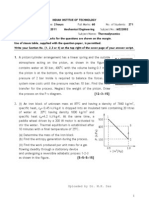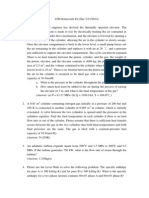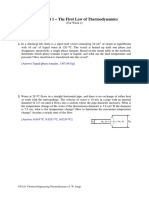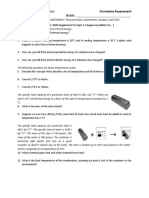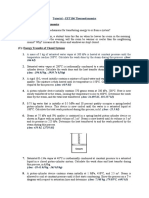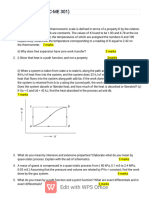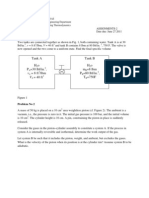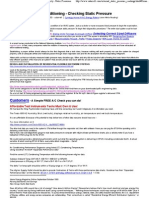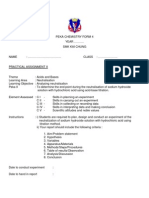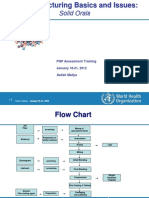Tutorial 2
Tutorial 2
Uploaded by
Divya VoraCopyright:
Available Formats
Tutorial 2
Tutorial 2
Uploaded by
Divya VoraOriginal Description:
Copyright
Available Formats
Share this document
Did you find this document useful?
Is this content inappropriate?
Copyright:
Available Formats
Tutorial 2
Tutorial 2
Uploaded by
Divya VoraCopyright:
Available Formats
Tutorial – 2
Question 1: A tank having a volume of 0.85 m3 initially contains water as a two-phase
liquid–vapour mixture at 260oC and a quality of 0.7. Saturated water vapour at 260oC is
slowly withdrawn through a pressure-regulating valve at the top of the tank as energy is
transferred by heat to maintain the pressure constant in the tank. This continues until the tank
is filled with saturated vapour at 260oC. Determine the amount of heat transfer, in kJ. Neglect
all kinetic and potential energy effects.
Question 2: Show that in an adiabatic throttling process enthalpy is held constant.
Question 3: One mole of a gas at a temperature of 25oC and a pressure of 1 bar (the initial
state) is to be heated and compressed in a frictionless piston and cylinder to 300oC and 10 bar
(the final state). Compute the heat, work required, the change in the internal energy and the
entropy change along each of the following paths.
Path A. Isothermal (constant temperature) compression to 10 bars, and then isobaric (constant
pressure) heating to 300°C.
Path B. Isobaric heating to 300oC followed by isothermal compression to 10 bars.
Path C. A compression in which PVγ = constant, where γ = Cp/Cv, followed by an isobaric
cooling or heating, if necessary, to 300°C.
For simplicity, the gas is assumed to be ideal with Cp = 35 J/(mol K). Comment on the
observations obtained from the problem.
Question 4: Calculate the adiabatic flame temperature of CH4 burned in 50% excess air
inside an adiabatic burner. Assume that CH4 and air enters the burner at 298.15 K and
complete combustion takes place.
CH4 + 2O2 CO2+2H2O ( H of = -803.029 kJ )
Compound a b*103 c d e*10-5
O2 30.255 4.207 0 0 -1.887
CO2 45.369 8.688 0 0 -9.619
H2O 28.850 12.055 0 0 1.006
N2 27.270 4.930 0 0 0.333
Question 5: A tank containing 45 kg of liquid water initially at 45oC has one inlet and one
exit with equal mass flow rates. Liquid water enters at 45oC and a mass flow rate of 270 kg/h.
A cooling coil immersed in the water removes energy at a rate of 7.6 kW. The water is well
mixed by a paddle wheel so that the water temperature is uniform throughout. The power
input to the water from the paddle wheel is 0.6 kW. The pressures at the inlet and exit are
equal and all kinetic and potential energy effects can be ignored. Plot the variation of water
temperature with time.
You might also like
- 143Document15 pages143Fikret BazNo ratings yet
- Topic 3 Problem Set 2016Document6 pagesTopic 3 Problem Set 2016Paul AmezquitaNo ratings yet
- Thermodynamics An Engineering Approach: Thermo 1 (MEP 261)Document22 pagesThermodynamics An Engineering Approach: Thermo 1 (MEP 261)cwidiNo ratings yet
- Vibrational Behaviour of The Turbo Generator Stator End Winding in CaseDocument12 pagesVibrational Behaviour of The Turbo Generator Stator End Winding in Casekoohestani_afshin67% (3)
- Mock Test For Chemistry For Engineers 2Document2 pagesMock Test For Chemistry For Engineers 2aramikaelatanNo ratings yet
- 2011 MidsemDocument2 pages2011 MidsemPrashant PrabhakarNo ratings yet
- ChE 204 HW-4 and HW-5 Together, Spring 2014, See Changes!Document5 pagesChE 204 HW-4 and HW-5 Together, Spring 2014, See Changes!Irene Kaye AceroNo ratings yet
- Homework #8 Solution Manual Thermodynamics Moran and ShapiroDocument10 pagesHomework #8 Solution Manual Thermodynamics Moran and Shapiroryan_martin_53100% (1)
- PR Closed System 2Document2 pagesPR Closed System 2Mareta DanarNo ratings yet
- Homework 01Document1 pageHomework 01sophixNo ratings yet
- ThermoDocument4 pagesThermowong zhi chengNo ratings yet
- Ned University of Engineering & Technology Department of Food Engineering Thermodynamics - Assignment SPRING SEMESTER 2020-2021Document4 pagesNed University of Engineering & Technology Department of Food Engineering Thermodynamics - Assignment SPRING SEMESTER 2020-2021Sahar Batool QaziNo ratings yet
- HW06 Ch06 OpenSystem USUFDocument3 pagesHW06 Ch06 OpenSystem USUFabdoag1691998No ratings yet
- THERMODYNAMICS 1 - SEPT 2017 PRESENTATION Rev 1 PDFDocument28 pagesTHERMODYNAMICS 1 - SEPT 2017 PRESENTATION Rev 1 PDFVictor John PingkianNo ratings yet
- Thermodynamics 1 - Sept 2017 Presentation Rev 1Document28 pagesThermodynamics 1 - Sept 2017 Presentation Rev 1Manoy BermeoNo ratings yet
- HW-04Document2 pagesHW-04jorge isaiasNo ratings yet
- Practice Problems On First Law For Closed SystemDocument3 pagesPractice Problems On First Law For Closed SystemNetra PujarNo ratings yet
- CHEMICAL THERMODYNAMICS (PPS) (N)Document19 pagesCHEMICAL THERMODYNAMICS (PPS) (N)kirtibalathakur6No ratings yet
- ENGR 205 Assignment#3Document3 pagesENGR 205 Assignment#3s-basma.mokhtarNo ratings yet
- ME 301 HW#6 Due: Monday 3/19/2018: C C H HDocument1 pageME 301 HW#6 Due: Monday 3/19/2018: C C H HfNo ratings yet
- HW4Document1 pageHW4Shanka UdugampolaNo ratings yet
- Thermodynamics QuestionsDocument4 pagesThermodynamics Questionsprateek vyasNo ratings yet
- PS21 FinalsReviewerDocument2 pagesPS21 FinalsReviewerIan De La CruzNo ratings yet
- Assignment 1 - The First Law of ThermodynamicsDocument2 pagesAssignment 1 - The First Law of ThermodynamicsTan Song KaiNo ratings yet
- KasdkfjDocument10 pagesKasdkfjPravallika KolliparaNo ratings yet
- Uts TermodinamikaDocument6 pagesUts TermodinamikaFadhillah AnsyariNo ratings yet
- The Enthalpy - Entropy Diagram For Steam (MOLLIER CHART) : Problems On Processes of VaporsDocument5 pagesThe Enthalpy - Entropy Diagram For Steam (MOLLIER CHART) : Problems On Processes of VaporsEnriv Yasilad50% (4)
- Department of Biomedical Engineering (Aait) : Work Sheet #3Document4 pagesDepartment of Biomedical Engineering (Aait) : Work Sheet #3gfsfNo ratings yet
- ChE 122 LE1 Samplex 2Document3 pagesChE 122 LE1 Samplex 2googley71No ratings yet
- Assignment 2 - Applied Thermodynamics - Fall 2023Document2 pagesAssignment 2 - Applied Thermodynamics - Fall 2023areebarajpoot0453879No ratings yet
- 23mee202et Questionbooklet-2-1Document9 pages23mee202et Questionbooklet-2-1rethinagiriswaransheshanthNo ratings yet
- Thermodynamics HomeworkDocument3 pagesThermodynamics HomeworkMinhNo ratings yet
- Assignment 1 First Law 2016Document8 pagesAssignment 1 First Law 2016PabitraBadhuk0% (1)
- Topic 3 Problem Set 2016Document5 pagesTopic 3 Problem Set 2016Dharmesh Ramnarayan YadavNo ratings yet
- T 2Document1 pageT 2jfl2096No ratings yet
- More Problems in Pure SubstanceDocument3 pagesMore Problems in Pure SubstancedeyhritamNo ratings yet
- Tutorial 2Document2 pagesTutorial 2Nayli SorfinaNo ratings yet
- Example 4Document41 pagesExample 4Akatew Haile MebrahtuNo ratings yet
- Thermodynamics (PC-ME 301) Question BankDocument7 pagesThermodynamics (PC-ME 301) Question Bankmajihiranmoy4635No ratings yet
- Tutorial 2Document2 pagesTutorial 2FaiqNo ratings yet
- 73 1st Long Problem Set BDocument13 pages73 1st Long Problem Set BRicardo Jose BracamonteNo ratings yet
- A7 - 20-SEP-2016 - RM001 - POCE5 - Module-4-Energy Balance-NumericalsDocument17 pagesA7 - 20-SEP-2016 - RM001 - POCE5 - Module-4-Energy Balance-NumericalssantoshNo ratings yet
- Homework7 2 December 2015Document2 pagesHomework7 2 December 2015Anonymous LD66FePU100% (1)
- CH 18Document22 pagesCH 18nallilathaNo ratings yet
- Home Work 3Document4 pagesHome Work 3Husiyandi HusniNo ratings yet
- Problem Sheet-03 ME201 1st LawDocument2 pagesProblem Sheet-03 ME201 1st LawPratyusha SatpathyNo ratings yet
- Pressure Temperature Dryness FractionDocument13 pagesPressure Temperature Dryness FractionbksinghsNo ratings yet
- Exercise 4 - Analysis of Closed SystemDocument3 pagesExercise 4 - Analysis of Closed SystemPuviin VarmanNo ratings yet
- Thermodynamics Tutorial ProblemsDocument20 pagesThermodynamics Tutorial ProblemsRishabh Sharma100% (1)
- Test 1 With AnsDocument4 pagesTest 1 With AnsKavinesh GanesanNo ratings yet
- Practice Problem (Chap # 03)Document4 pagesPractice Problem (Chap # 03)nandlalwarsoorNo ratings yet
- Kkpk1223 Chemical Engineering Thermodynamics I Tutorial Vi SEMESTER II 2023/2024Document2 pagesKkpk1223 Chemical Engineering Thermodynamics I Tutorial Vi SEMESTER II 2023/2024catrineNo ratings yet
- Tutorial 6 Question ThermodynamicsDocument3 pagesTutorial 6 Question ThermodynamicsWaheeda SainiNo ratings yet
- ESO201A Tutorial 3Document17 pagesESO201A Tutorial 3Arnav HarshitNo ratings yet
- ThermoDocument5 pagesThermoTerry Clarice DecatoriaNo ratings yet
- Work Sheet1Document4 pagesWork Sheet1Tesfa negaNo ratings yet
- Homework BDocument28 pagesHomework BPravallika Kollipara0% (2)
- QB Unit 1Document6 pagesQB Unit 1Gaurav GadhesariaNo ratings yet
- Question Bank (Numericals)Document12 pagesQuestion Bank (Numericals)Omid Karimi SadaghianiNo ratings yet
- Practice Makes Perfect in Chemistry: The Physical Behavior of MatterFrom EverandPractice Makes Perfect in Chemistry: The Physical Behavior of MatterRating: 5 out of 5 stars5/5 (1)
- Cambridge Igcse Chemistry Practical Workbook仅40页Document40 pagesCambridge Igcse Chemistry Practical Workbook仅40页jj80% (5)
- Acid Frac Critic AcidDocument4 pagesAcid Frac Critic Acidamramazon88No ratings yet
- 3 Conduction of ImpulseDocument23 pages3 Conduction of ImpulseZuhaib AhmedNo ratings yet
- Improving Gas Well Deliverability A Case Study: Results???Document3 pagesImproving Gas Well Deliverability A Case Study: Results???Sayid SimbaddaNo ratings yet
- Static Pressure Concept 1Document8 pagesStatic Pressure Concept 1bharath477No ratings yet
- Indice de BromoDocument7 pagesIndice de Bromopons5No ratings yet
- Quantum Electrodynamics: 12.1 Gauge Invariant Interacting TheoryDocument99 pagesQuantum Electrodynamics: 12.1 Gauge Invariant Interacting TheoryPedro SimoesNo ratings yet
- Fluorescent Dyes and Pigments - Ullman's PDFDocument22 pagesFluorescent Dyes and Pigments - Ullman's PDFreneangelo100% (1)
- Rocky Hydro CalcDocument11 pagesRocky Hydro Calcpd110382No ratings yet
- 1 s2.0 S1319016413001114 MainDocument41 pages1 s2.0 S1319016413001114 MainEr Omkar Ravindra MhatreNo ratings yet
- Installation and Maintenance Manual-BMS - Parameter List For CTC EcoHeat-16220113Document8 pagesInstallation and Maintenance Manual-BMS - Parameter List For CTC EcoHeat-16220113Ion BogdanNo ratings yet
- Preparation of Buffer Solution: Prepared By: Dr. Wafa FarooqDocument29 pagesPreparation of Buffer Solution: Prepared By: Dr. Wafa FarooqHamid AlyadumiNo ratings yet
- Peka - Chemistry Form 4 - Student's and Teacher's Manual - 02 - Acid Base TitrationDocument4 pagesPeka - Chemistry Form 4 - Student's and Teacher's Manual - 02 - Acid Base TitrationWong Wai Lun88% (17)
- Science 6 Summative Test 1 Quarter 1Document4 pagesScience 6 Summative Test 1 Quarter 1Hieronymus AlpantaNo ratings yet
- Guide To NEMA and IEC Enclosure RatingsDocument3 pagesGuide To NEMA and IEC Enclosure RatingsChris Anthony VianaNo ratings yet
- Campomanesia Lineatifolia: Characterization of Odor-Active Volatiles in Champa (R. & P.)Document8 pagesCampomanesia Lineatifolia: Characterization of Odor-Active Volatiles in Champa (R. & P.)Daniel AriasNo ratings yet
- Cambridge Secondary 1 Checkpoint: Cambridge Assessment International EducationDocument19 pagesCambridge Secondary 1 Checkpoint: Cambridge Assessment International EducationArsen RahymbekovNo ratings yet
- Neo Neet 11 p1 Che e Redox Reactions s4 211Document106 pagesNeo Neet 11 p1 Che e Redox Reactions s4 211ritamnath337No ratings yet
- Acetone (Qrec)Document4 pagesAcetone (Qrec)Inasha VaseanyNo ratings yet
- 15.P.sathIYA 2009 Optimization of Friction Welding Parameters UsingDocument9 pages15.P.sathIYA 2009 Optimization of Friction Welding Parameters UsingSyarif HidayatullahNo ratings yet
- Questions and Answers For NCERT Book XDocument9 pagesQuestions and Answers For NCERT Book XPrabhuPalanichamyNo ratings yet
- Sedimentation and Elutration PDFDocument14 pagesSedimentation and Elutration PDFTapas Das50% (4)
- Biology Catalase Experiment DesignDocument6 pagesBiology Catalase Experiment DesignLata SharmaNo ratings yet
- 1-7 Manufacturing BasicsDocument29 pages1-7 Manufacturing Basicselektron2010No ratings yet
- Making of Standardization Solution KMnO4Document8 pagesMaking of Standardization Solution KMnO4Ika Ariyani Basir100% (1)
- Electric DrivesDocument52 pagesElectric DrivesPanhwer Sajid AliNo ratings yet
- Standard Cylinder DNC-63 - PPV-A: Data SheetDocument1 pageStandard Cylinder DNC-63 - PPV-A: Data SheetAnonymous 1JHrgYNo ratings yet
- Aharonov Bohm PDFDocument40 pagesAharonov Bohm PDFMadeleine LafleurNo ratings yet
- Simon C. Bott Et Al - Quantitative Measurements of Wire Ablation in Tungsten X-Pinches at 80 KaDocument6 pagesSimon C. Bott Et Al - Quantitative Measurements of Wire Ablation in Tungsten X-Pinches at 80 KaCola7890No ratings yet





